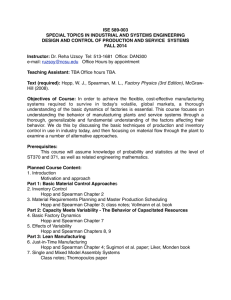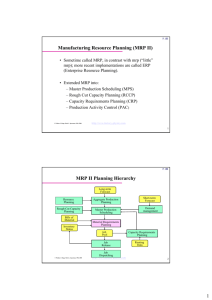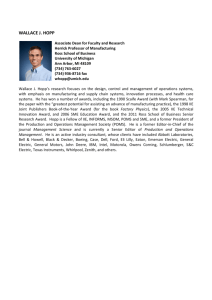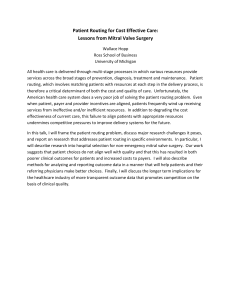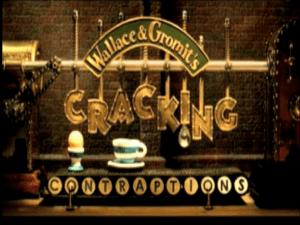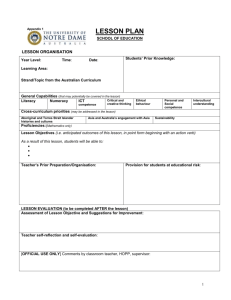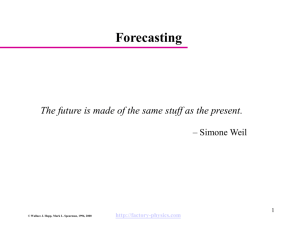Base Stock Example
advertisement
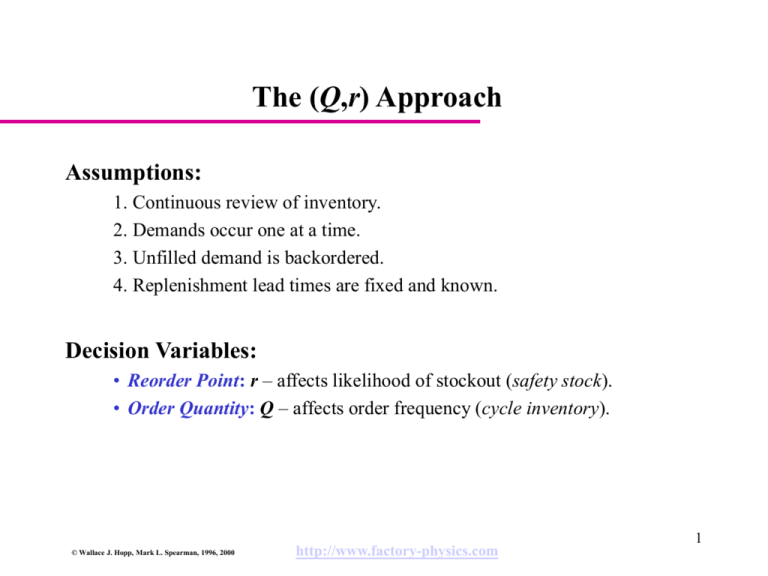
The (Q,r) Approach
Assumptions:
1. Continuous review of inventory.
2. Demands occur one at a time.
3. Unfilled demand is backordered.
4. Replenishment lead times are fixed and known.
Decision Variables:
• Reorder Point: r – affects likelihood of stockout (safety stock).
• Order Quantity: Q – affects order frequency (cycle inventory).
© Wallace J. Hopp, Mark L. Spearman, 1996, 2000
http://www.factory-physics.com
1
Inventory
Inventory vs Time in (Q,r) Model
Q
r
l
Time
© Wallace J. Hopp, Mark L. Spearman, 1996, 2000
http://www.factory-physics.com
2
Base Stock Model Assumptions
1. There is no fixed cost associated with placing an order.
2. There is no constraint on the number of orders that can be
placed per year.
© Wallace J. Hopp, Mark L. Spearman, 1996, 2000
http://www.factory-physics.com
3
Base Stock Notation
Q
r
R
= 1, order quantity (fixed at one)
= reorder point
= r +1, base stock level
l
= delivery lead time
q
= mean demand during l
= std dev of demand during l
p(x)
= Prob{demand during lead time l equals x}
G(x)
= Prob{demand during lead time l is less than or equal to x}
h
b
S(R)
B(R)
I(R)
=
=
=
=
=
unit holding cost
unit backorder cost
average fill rate (service level)
average backorder level
average on-hand inventory level
© Wallace J. Hopp, Mark L. Spearman, 1996, 2000
http://www.factory-physics.com
4
Inventory Balance Equations
Balance Equation:
inventory position = on-hand inventory - backorders + orders
Under Base Stock Policy
inventory position = R
© Wallace J. Hopp, Mark L. Spearman, 1996, 2000
http://www.factory-physics.com
5
Service Level (Fill Rate)
Let:
X = (random) demand during lead time l
so E[X] = q. Consider a specific replenishment order. Since
inventory position is always R, the only way this item can stock out is
if X R.
Expected Service Level:
G ( R), if G is continuous
S ( R) P( X R)
G ( R 1) G (r ), if G is discrete
© Wallace J. Hopp, Mark L. Spearman, 1996, 2000
http://www.factory-physics.com
6
Backorder Level
Note: At any point in time, number of orders equals number demands
during last l time units (X) so from our previous balance equation:
R = on-hand inventory - backorders + orders
on-hand inventory - backorders = R - X
Note: on-hand inventory and backorders are never positive at the same
time, so if X=x, then
if x R
0,
backorders
x R, if x R
simpler version for
Expected Backorder Level:
spreadsheet computing
B(r )
( x r ) p( x) qp(r ) (q r )[1 G(r )]
x r 1
© Wallace J. Hopp, Mark L. Spearman, 1996, 2000
http://www.factory-physics.com
7
Inventory Level
Observe:
• on-hand inventory - backorders = R-X
• E[X] = q from data
• E[backorders] = B(R) from previous slide
Result:
I(R) = R - q + B(R)
© Wallace J. Hopp, Mark L. Spearman, 1996, 2000
http://www.factory-physics.com
8
Base Stock Example
l = one month
q = 10 units (per month)
Assume Poisson demand, so
10k e 10
G( x) p(k )
k!
k 0
k 0
x
© Wallace J. Hopp, Mark L. Spearman, 1996, 2000
x
http://www.factory-physics.com
Note: Poisson
demand is a good
choice when no
variability data
is available.
9
Base Stock Example Calculations
r
0
1
2
3
4
5
6
7
8
9
10
11
p(r)
0.000
0.000
0.002
0.008
0.019
0.038
0.063
0.090
0.113
0.125
0.125
0.114
G(r)
0.000
0.000
0.003
0.010
0.029
0.067
0.130
0.220
0.333
0.458
0.583
0.697
© Wallace J. Hopp, Mark L. Spearman, 1996, 2000
B(r)
10.000
9.000
8.001
7.003
6.014
5.043
4.110
3.240
2.460
1.793
1.251
0.834
r
12
13
14
15
16
17
18
19
20
21
22
23
p(r)
0.095
0.073
0.052
0.035
0.022
0.013
0.007
0.004
0.002
0.001
0.000
0.000
http://www.factory-physics.com
G(r)
0.792
0.864
0.917
0.951
0.973
0.986
0.993
0.997
0.998
0.999
0.999
1.000
B(r)
0.531
0.322
0.187
0.103
0.055
0.028
0.013
0.006
0.003
0.001
0.000
0.000
10
Base Stock Example Results
Service Level: For fill rate of 90%, we must set R-1= r =14, so R=15 and
safety stock s = r-q = 4. Resulting service is 91.7%.
Backorder Level:
B(r) = 0.187
Inventory Level:
I(R) = R - q + B(R) = 15 - 10 + 0.187 = 5.187
© Wallace J. Hopp, Mark L. Spearman, 1996, 2000
http://www.factory-physics.com
11
“Optimal” Base Stock Levels
Objective Function:
holding plus backorder cost
Y(R) = hI(R) + bB(R)
= h(R-q+B(R)) + bB(R)
= h(R- q) + (h+b)B(R)
Solution: if we assume G is continuous, we can use calculus to get
b
G(R* )
hb
Implication: set base stock
level so fill rate is b/(h+b).
Note: R* increases in b and
decreases in h.
© Wallace J. Hopp, Mark L. Spearman, 1996, 2000
http://www.factory-physics.com
12
Base Stock Normal Approximation
If G is normal(q,), then
b
G ( R*)
hb
R * q
z
where (z)=b/(h+b). So
R* = q + z
© Wallace J. Hopp, Mark L. Spearman, 1996, 2000
Note: R* increases in
and also increases in
provided z>0.
http://www.factory-physics.com
13
“Optimal” Base Stock Example
Data: Approximate Poisson with mean 10 by normal with mean 10
units/month and standard deviation 10 = 3.16 units/month. Set
h=$15, b=$25.
Calculations:
b
25
0.625
h b 15 25
since (0.32) = 0.625, z=0.32 and hence
R* = q + z = 10 + 0.32(3.16) = 11.01 11
Observation: from previous table fill rate is G(10) = 0.583, so maybe
backorder cost is too low.
© Wallace J. Hopp, Mark L. Spearman, 1996, 2000
http://www.factory-physics.com
14
Inventory Pooling
Situation:
• n different parts with lead time demand normal(q, )
• z=2 for all parts (i.e., fill rate is around 97.5%)
Specialized Inventory:
cycle stock
• base stock level for each item = q + 2
• total safety stock = 2n
safety stock
Pooled Inventory: suppose parts are substitutes for one another
• lead time demand is normal (n q,n )
• base stock level (for same service) = n q+2 n
• ratio of safety stock to specialized safety stock = 1/ n
© Wallace J. Hopp, Mark L. Spearman, 1996, 2000
http://www.factory-physics.com
15
Effect of Pooling on Safety Stock
Conclusion: cycle stock is
not affected by pooling, but
safety stock falls dramatically.
So, for systems with high safety
stock, pooling (through product
design, late customization, etc.)
can be an attractive strategy.
© Wallace J. Hopp, Mark L. Spearman, 1996, 2000
http://www.factory-physics.com
16
Pooling Example
•
PC’s consist of 6 components (CPU, HD, CD ROM, RAM,
removable storage device, keyboard)
•
3 choices of each component: 36 = 729 different PC’s
•
Each component costs $150 ($900 material cost per PC)
•
Demand for all models is Poisson distributed with mean
100 per year
•
Replenishment lead time is 3 months (0.25 years)
•
Use base stock policy with fill rate of 99%
© Wallace J. Hopp, Mark L. Spearman, 1996, 2000
http://www.factory-physics.com
17
Pooling Example - Stock PC’s
Base Stock Level for Each PC: q = 100 0.25 = 25, so using
Poisson formulas,
G(R-1) 0.99
R = 38 units
On-Hand Inventory for Each PC:
I(R) = R - q + B(R) = 38 - 25 + 0.023 = 13.023 units
Total (Approximate) On-Hand Inventory :
13.023 729 $900 = $8,544,390
© Wallace J. Hopp, Mark L. Spearman, 1996, 2000
http://www.factory-physics.com
18
Pooling Example - Stock Components
729 models of PC
3 types of each comp.
Necessary Service for Each Component:
S = (0.99)1/6 = 0.9983
Base Stock Level for Components:q = (100 729/3)0.25 = 6075, so
G(R-1) 0.9983
R = 6306
On-Hand Inventory Level for Each Component:
I(R) = R - q + B(R) = 6306-6075+0.0363 = 231.0363 units
Total Safety Stock:
231.0363 18 $150 = $623,798
© Wallace J. Hopp, Mark L. Spearman, 1996, 2000
93% reduction!
http://www.factory-physics.com
19
Base Stock Insights
1. Reorder points control the probability of stockouts by establishing safety
stock.
2. The “optimal” fill rate is an increasing function of the backorder cost and
a decreasing function of the holding cost. We can use either a service
constraint or a backorder cost to determine the appropriate base stock
level.
3. Base stock levels in multi-stage production systems are very similar to
kanban systems and therefore the above insights apply to those systems
as well.
4. Base stock model allows us to quantify benefits of inventory pooling.
© Wallace J. Hopp, Mark L. Spearman, 1996, 2000
http://www.factory-physics.com
20
The Single Product (Q,r) Model
Motivation: Either
1. Fixed cost associated with replenishment orders and cost per backorder.
2. Constraint on number of replenishment orders per year and service
constraint.
Objective: Under (1)
min fixed setup cost holding cost backorder cost
Q,r
As in EOQ, this makes
batch production attractive.
© Wallace J. Hopp, Mark L. Spearman, 1996, 2000
http://www.factory-physics.com
21
(Q,r) Notation
D expected demand per year
replenishment lead time (assumed constant)
X (random) demand during replenishment lead time
q E[ X ] expected demand during replenishment lead time
standard deviation of demand during replenishment lead time
p(x) P( X x) pmf of demand during lead time
G ( x) P( X x ) cdf of demand during lead time
A fixed cost per order
c unit cost of an item
h annual unit holding cost
k cost per stockout
b annual unit backorder cost
© Wallace J. Hopp, Mark L. Spearman, 1996, 2000
http://www.factory-physics.com
22
(Q,r) Notation (cont.)
Decision Variables:
Q
r
s
order quantity
reorder point
r q safety stock implied by r
Performance Measures:
F (Q) average order frequency
S (Q, r ) average service level (fill rate)
B(Q, r ) average backorder level
I (Q, r ) average inventory level
© Wallace J. Hopp, Mark L. Spearman, 1996, 2000
http://www.factory-physics.com
23
Inventory and Inventory Position for Q=4, r=4
9
Inventory Position
uniformly distributed
between r+1=5 and
r+Q=8
8
7
6
Quantity
5
4
3
2
1
0
-1
0
2
4
6
8
10
12
14
16
18
20
22
24
26
28
30
32
-2
Time
Inventory Position
© Wallace J. Hopp, Mark L. Spearman, 1996, 2000
Net Inventory
http://www.factory-physics.com
24
Costs in (Q,r) Model
Fixed Setup Cost: AF(Q)
Stockout Cost: kD(1-S(Q,r)), where k is cost per stockout
Backorder Cost: bB(Q,r)
Inventory Carrying Costs: cI(Q,r)
© Wallace J. Hopp, Mark L. Spearman, 1996, 2000
http://www.factory-physics.com
25
Fixed Setup Cost in (Q,r) Model
Observation: since the number of orders per year is D/Q,
F(Q)
© Wallace J. Hopp, Mark L. Spearman, 1996, 2000
D
Q
http://www.factory-physics.com
26
Stockout Cost in (Q,r) Model
Key Observation: inventory position is uniformly distributed between
r+1 and r+Q. So, service in (Q,r) model is weighted sum of service
in base stock model.
Result:
1 r Q
1
S (Q, r )
G ( x 1) [G (r ) G (r Q 1)]
Q x r 1
Q
Note: this form is easier to use
1
S (Q, r ) 1 [ B (r ) B(r Q )]
in spreadsheets because it does
Q
not involve a sum.
© Wallace J. Hopp, Mark L. Spearman, 1996, 2000
http://www.factory-physics.com
27
Service Level Approximations
Type I (base stock):
S (Q, r ) G(r )
Note: computes number
of stockouts per cycle,
underestimates S(Q,r)
Type II:
B(r )
S (Q, r ) 1
Q
© Wallace J. Hopp, Mark L. Spearman, 1996, 2000
Note: neglects B(r,Q)
term, underestimates S(Q,r)
http://www.factory-physics.com
28
Backorder Costs in (Q,r) Model
Key Observation: B(Q,r) can also be computed by averaging base stock
backorder level function over the range [r+1,r+Q].
Result:
1 r Q
1
B(Q, r )
B( x) [ B(r 1) B(r Q)]
Q x r 1
Q
Notes:
1. B(Q,r)
B(r) is a base stock approximation for backorder level.
2. If we can compute B(x) (base stock backorder level function),
then we can compute stockout and backorder costs in (Q,r) model.
© Wallace J. Hopp, Mark L. Spearman, 1996, 2000
http://www.factory-physics.com
29
Inventory Costs in (Q,r) Model
Approximate Analysis: on average inventory declines from Q+s to
s+1 so
I (Q, r )
(Q s) ( s 1) Q 1
Q 1
s
r q
2
2
2
Exact Analysis: this neglects backorders, which add to average
inventory since on-hand inventory can never go below zero. The
corrected version turns out to be
I (Q, r )
© Wallace J. Hopp, Mark L. Spearman, 1996, 2000
Q 1
r q B(Q, r )
2
http://www.factory-physics.com
30
(Q,r) Model with Backorder Cost
Objective Function:
Y (Q, r )
D
A bB(Q, r ) hI (Q, r )
Q
Approximation: B(Q,r) makes optimization complicated because it
depends on both Q and r. To simplify, approximate with base stock
backorder formula, B(r):
D
Q 1
~
Y (Q, r ) Y (Q, r ) A bB(r ) h(
r q B(r ))
Q
2
© Wallace J. Hopp, Mark L. Spearman, 1996, 2000
http://www.factory-physics.com
31
Results of Approximate Optimization
Assumptions:
• Q,r can be treated as continuous variables
• G(x) is a continuous cdf
Results:
2 AD
h
b
G (r*)
hb
Q*
Note: this is just the EOQ formula
r* q z
Note: this is just the
base stock formula
if G is normal( , ),
where (z)=b/(h+b)
© Wallace J. Hopp, Mark L. Spearman, 1996, 2000
http://www.factory-physics.com
32
(Q,r) Example
D = 14 units per year
c = $150 per unit
h = 0.1 × 150 = $15 per unit
l = 45 days
q = (14 × 45)/365 = 1.726 units during replenishment lead time
A = $10
b = $40
Demand during lead time is Poisson
© Wallace J. Hopp, Mark L. Spearman, 1996, 2000
http://www.factory-physics.com
33
Values for Poisson(q) Distribution
r
p(r)
G(r)
B(r)
0
1
2
3
4
5
6
7
8
9
10
0.178
0.307
0.265
0.153
0.066
0.023
0.007
0.002
0.000
0.000
0.000
0.178
0.485
0.750
0.903
0.969
0.991
0.998
1.000
1.000
1.000
1.000
1.726
0.904
0.389
0.140
0.042
0.011
0.003
0.001
0.000
0.000
0.000
34
Calculations for Example
Q*
2 AD
h
2(10 )(14 )
4 .3 4
15
b
40
0.615
h b 15 40
(0.29 ) 0.615 , so z 0.29
r* q z 1.726 0.29 (1.314 ) 2.107 2
© Wallace J. Hopp, Mark L. Spearman, 1996, 2000
http://www.factory-physics.com
35
Performance Measures for Example
F (Q*)
D
14
3. 5
Q* 4
1
1
[ B (r*) B (r * Q*)] 1 [ B ( 2) B (2 4)]
Q*
Q
1
1 [0.389 0.003 ] 0.904
4
S(Q * ,r * ) 1
1 r * Q *
1
B (Q*, r*)
B
(
x
)
[ B (3) B (4) B (5) B (6)]
Q * x r *1
Q
1
[0.140 0.042 0.011 0.003 ] 0.049
4
I (Q*, r*)
Q * 1
4 1
r * q B (Q*, r*)
2 1.726 0.049 2.823
2
2
© Wallace J. Hopp, Mark L. Spearman, 1996, 2000
http://www.factory-physics.com
36
Observations on Example
•
Orders placed at rate of 3.5 per year
•
Fill rate fairly high (90.4%)
•
Very few outstanding backorders (0.049 on average)
•
Average on-hand inventory just below 3 (2.823)
© Wallace J. Hopp, Mark L. Spearman, 1996, 2000
http://www.factory-physics.com
37
Varying the Example
Change: suppose we order twice as often so F=7 per year, then Q=2 and:
S (Q, r ) 1
1
1
[ B(r ) B(r Q)] 1 [0.389 0.042 ] 0.826
Q
2
which may be too low, so increase r from 2 to 3:
S (Q, r ) 1
1
1
[ B(r ) B(r Q)] 1 [0.140 0.011] 0.936
Q
2
This is better. For this policy (Q=2, r=4) we can compute B(2,3)=0.026,
I(Q,r)=2.80.
Conclusion: this has higher service and lower inventory than the original
policy (Q=4, r=2). But the cost of achieving this is an extra 3.5
replenishment orders per year.
© Wallace J. Hopp, Mark L. Spearman, 1996, 2000
http://www.factory-physics.com
38
(Q,r) Model with Stockout Cost
Objective Function:
Y (Q, r )
D
A kD(1 S (Q, r )) hI (Q, r )
Q
Approximation: Assume we can still use EOQ to compute Q* but
replace S(Q,r) by Type II approximation and B(Q,r) by base stock
approximation:
D
B(r )
Q 1
~
Y (Q, r ) Y (Q, r ) A kD
h(
r q B(r ))
Q
Q
2
© Wallace J. Hopp, Mark L. Spearman, 1996, 2000
http://www.factory-physics.com
39
Results of Approximate Optimization
Assumptions:
• Q,r can be treated as continuous variables
• G(x) is a continuous cdf
Results:
2 AD
Q*
h
kD
G (r*)
kD hQ
Note: this is just the EOQ formula
r* q z
if G is normal( , ),
where (z)=kD/(kD+hQ)
© Wallace J. Hopp, Mark L. Spearman, 1996, 2000
http://www.factory-physics.com
Note: another version
of base stock formula
(only z is different)
40
Backorder vs. Stockout Model
Backorder Model
• when real concern is about stockout time
• because B(Q,r) is proportional to time orders wait for backorders
• useful in multi-level systems
Stockout Model
• when concern is about fill rate
• better approximation of lost sales situations (e.g., retail)
Note:
• We can use either model to generate frontier of solutions
• Keep track of all performance measures regardless of model
• B-model will work best for backorders, S-model for stockouts
© Wallace J. Hopp, Mark L. Spearman, 1996, 2000
http://www.factory-physics.com
41
Lead Time Variability
Problem: replenishment lead times may be variable, which
increases variability of lead time demand.
Notation:
L = replenishment lead time (days), a random variable
l
= E[L] = expected replenishment lead time (days)
L = std dev of replenishment lead time (days)
Dt = demand on day t, a random variable, assumed independent and
identically distributed
d = E[Dt] = expected daily demand
D = std dev of daily demand (units)
© Wallace J. Hopp, Mark L. Spearman, 1996, 2000
http://www.factory-physics.com
42
Including Lead Time Variability in Formulas
Standard Deviation of Lead Time Demand:
if demand is Poisson
D2 d 2 L2 q d 2 L2
Inflation term due to
lead time variability
Modified Base Stock Formula (Poisson demand case):
R q z q z q d
2
© Wallace J. Hopp, Mark L. Spearman, 1996, 2000
2
L
Note: can be used in any
base stock or (Q,r) formula
as before. In general, it will
inflate safety stock.
http://www.factory-physics.com
43
Single Product (Q,r) Insights
Basic Insights:
• Safety stock provides a buffer against stockouts.
• Cycle stock is an alternative to setups/orders.
Other Insights:
1. Increasing D tends to increase optimal order quantity Q.
2. Increasing q tends to increase the optimal reorder point. (Note: either
increasing D or l increases q.)
3. Increasing the variability of the demand process tends to increase the
optimal reorder point (provided z > 0).
4. Increasing the holding cost tends to decrease the optimal order quantity
and reorder point.
© Wallace J. Hopp, Mark L. Spearman, 1996, 2000
http://www.factory-physics.com
44
